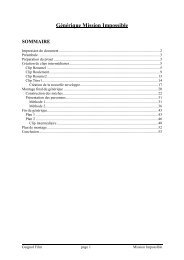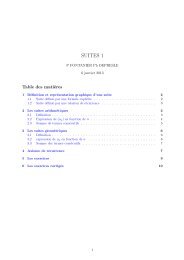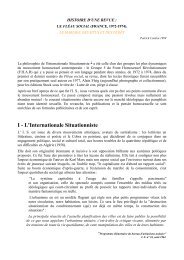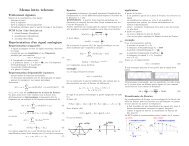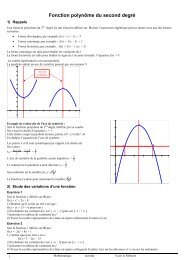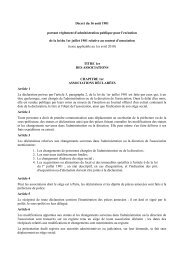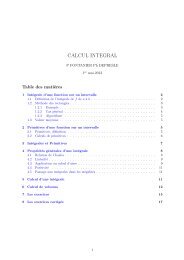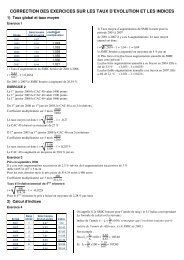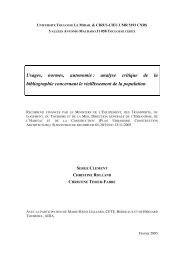internationalisation in science in the prism of bibliometric indicators
internationalisation in science in the prism of bibliometric indicators
internationalisation in science in the prism of bibliometric indicators
You also want an ePaper? Increase the reach of your titles
YUMPU automatically turns print PDFs into web optimized ePapers that Google loves.
<strong>of</strong> geography". The capability <strong>of</strong> ICT to get rid <strong>of</strong> proximity effects<br />
and/or strong <strong>in</strong>ertia <strong>of</strong> socio-political structures should not be<br />
overstated. Reshap<strong>in</strong>g <strong>of</strong> communication networks will probably be slower<br />
as expected.<br />
3. Some <strong><strong>in</strong>ternationalisation</strong> measures amenable to <strong>bibliometric</strong>s<br />
Internationalisation and <strong>in</strong>ternationalism <strong>in</strong> <strong>science</strong> take a variety<br />
<strong>of</strong> forms (Crawford et al., 1992; Elz<strong>in</strong>ga & Landstrom, 1996). They<br />
encompass all dimensions <strong>of</strong> research systems: economic resources<br />
(programmes and fund<strong>in</strong>g systems; shared <strong>in</strong>frastructures, bilateral and<br />
multilateral agreements); human resources (teach<strong>in</strong>g system and labour<br />
market <strong>of</strong> skilled manpower: PhD, postdoc, scientists; migrations,<br />
diasporas and networks, bra<strong>in</strong> dra<strong>in</strong> and bra<strong>in</strong> ga<strong>in</strong>); rules and norms <strong>of</strong><br />
<strong>the</strong> community; general policy and governance levels.<br />
In each area, various modalities <strong>of</strong> <strong><strong>in</strong>ternationalisation</strong> can be<br />
observed. One concerns <strong>the</strong> reduction <strong>of</strong> particular market imperfections<br />
due to <strong>the</strong> national factors. Examples are progresses <strong>in</strong> <strong>in</strong>ternational<br />
skilled labour mobility and reduction <strong>of</strong> nationally-oriented publish<strong>in</strong>g<br />
behaviour. Ano<strong>the</strong>r axis concerns coord<strong>in</strong>ation and cooperation<br />
mechanisms, with sometimes a focus on reduction <strong>of</strong> <strong>in</strong>ternational<br />
unevenness (EU structural funds and framework programs). Whe<strong>the</strong>r <strong>the</strong><br />
reduction <strong>of</strong> barriers to competition and collaboration leads to a more<br />
equal distribution <strong>of</strong> f<strong>in</strong>al outcomes - <strong>the</strong> convergence issue - is a<br />
crucial issue <strong>of</strong> globalisation studies. The question arises <strong>in</strong> a<br />
critical manner for bra<strong>in</strong>-dra<strong>in</strong>, where <strong><strong>in</strong>ternationalisation</strong> <strong>of</strong> skilled<br />
labour market results so far <strong>in</strong> a strongly dissymmetrical flow between<br />
<strong>the</strong> US and <strong>the</strong> rest <strong>of</strong> <strong>the</strong> world, with high benefits for <strong>the</strong> centre<br />
(Stephan & Lev<strong>in</strong>, 1999). More generally, <strong>bibliometric</strong> distribution<br />
studies provided overwhelm<strong>in</strong>g evidence that scientific competition does<br />
produce skew distributions. Internationalisation is far from be<strong>in</strong>g a<br />
consistent process where remov<strong>in</strong>g barriers would necessarily mean a<br />
reduction <strong>of</strong> discrepancies.<br />
In <strong>the</strong> follow<strong>in</strong>g we will address three forms <strong>of</strong><br />
<strong><strong>in</strong>ternationalisation</strong>:<br />
a) <strong><strong>in</strong>ternationalisation</strong> as a reduction <strong>of</strong> national barriers to<br />
competition: is scientific communication <strong>in</strong>ternationalised? We will<br />
focus on <strong>the</strong> core <strong>of</strong> "certified" communication, scientific journals,<br />
which are a central locus <strong>of</strong> communication and competition among<br />
scientists.<br />
b) <strong><strong>in</strong>ternationalisation</strong> as a reduction <strong>of</strong> national barriers to<br />
cooperation: it is generally admitted that <strong>the</strong> fabric <strong>of</strong> scientific<br />
<strong>in</strong>terdependence networks, at <strong>the</strong> <strong>in</strong>ternational level, is tighter and<br />
tighter. Does it mean a more open space? Here we will have a look at<br />
co-publication networks.<br />
c) <strong><strong>in</strong>ternationalisation</strong> as a reduction <strong>of</strong> <strong>the</strong> national factor <strong>in</strong> f<strong>in</strong>al<br />
outcome distribution: are empirical convergence phenomena observed




